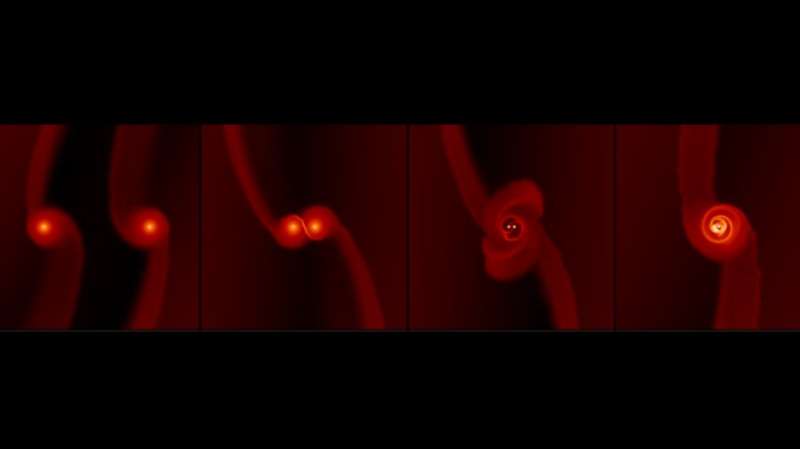This article has been reviewed according to Science X's editorial process and policies. Editors have highlighted the following attributes while ensuring the content's credibility:
fact-checked
trusted source
proofread
Quasar disks could host black hole collision events

New research, in the wake of the gravitational wave discoveries, sheds light on the environments that could lead to black hole merger events. The work is presented this week at the 2023 National Astronomy Meeting by Ph.D. student at the University of Oxford, Connar Rowan.
The first gravitational waves, predicted initially by Albert Einstein in 1916, were detected from Earth in 2015. However, determining their origin in the cosmos has been an open question. To be detectable across such vast distances, the gravitational waves we observe can only have come from pairs of large, highly dense objects in close proximity to each other, such as black hole or neutron star binaries. There have now been over 90 such detections, though the primary astrophysical environment that allows these objects to get close enough to emit gravitational waves remains a mystery.
One possible environment where black holes may undergo frequent mergers is in quasars. A quasar is a powerful active galactic nucleus powered by a supermassive black hole. A dense disk of gas swirls around a supermassive black hole close to the speed of light, resulting in extremely bright emissions.
The interactions of stellar-mass black holes with the gas disk of a supermassive black hole are highly complex and require sophisticated computer simulations to be understood. In the new research, the team of astronomers from the University of Oxford and Columbia University examined the behavior of such disk-embedded stellar-mass black holes. The work suggests that stellar-mass black holes could be dragged into dense quasar gas disks and forced into binary systems by gravitational interactions with each other and the gas in the disks.
The team have performed high resolution simulations of the gaseous disk of a quasar containing two stellar-mass black holes. The aim of the simulation is to see if the black holes get captured into a gravitationally bound binary system and possibly merge at a later time within the gas disk. These simulations use 25 million gas particles to imitate the complex gas flows during the encounter, which requires a computational running time of around three months for each simulation.

The simulations show that the gas reduces the speed of the black holes during the encounter, so black holes that would normally simply fly apart remain gravitationally bound, trapped in orbit around each other while they both in turn orbit the supermassive black hole. This occurs through a mix of gravitational tugging between them and the massive gas streams in the disk and individual "mini" disks around the individual black holes.
In addition, the direct gas drag analogous to air resistance also plays a role where gas "eaten" by the black holes along their path forces them to decelerate. In response to absorbing the black hole kinetic energy via gravitational interaction, the gas is violently ejected immediately following the encounter. This outcome occurs in the majority of the simulations and confirms the previous expectations that gas greatly facilitates the capture of black holes into bound pairs.
It was also found that the direction of orbit of the black holes impacted how they evolved. In half of the retrograde binaries—binary systems where the black holes orbit each other in opposite direction to their orbit around the supermassive black hole—the black holes could get close enough to produce significant gravitational waves and very rapidly dissipate their orbital energy via these wave emissions, merging very abruptly.
Research lead Rowan says, "These simulations address two main questions: can gas catalyze black hole binary formation and if so, can they ultimately get even closer and merge? For this process to explain the origin of the observed gravitational wave signals, both answers need to be yes."
"These results are incredibly exciting as they validate that black hole mergers in supermassive black hole disks can happen, and possibly explain many or perhaps most of the gravitational wave signals we observe today," said Professor Bence Kocsis, co-author of the research paper.
"If a sizeable fraction of the observed events, either today or in the future, is caused by this phenomenon, we should be able to see a direct association between quasars and gravitational wave sources in the sky," adds Professor Zoltán Haiman of Columbia University, another co-author of the research paper.
Provided by Royal Astronomical Society





















